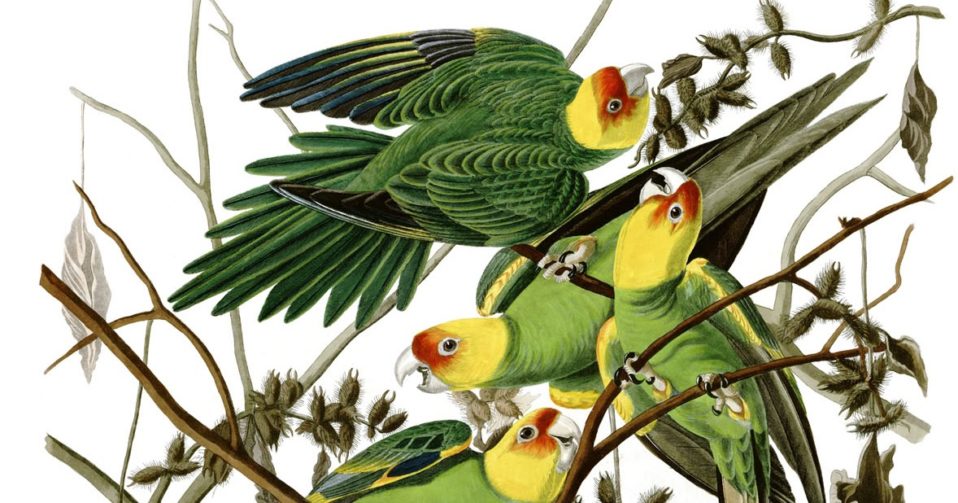Wildlife Wednesday: The American Parrots
We don’t usually think of the United States as a place where you can find parrots. We think of them as tropical birds, flying around, squawking, and eating fruit in a lush humid rain forest far away. However, this country has parrots, here and there. At one time, we had at least 2 native parrots within what is now the borders of the U.S., one of them being common and widespread across 2/3 of the country. Currently, we are left with only a few introduced species scattered across various small areas. And so, today, we have a look at a few of these species of American parrots, past and present.
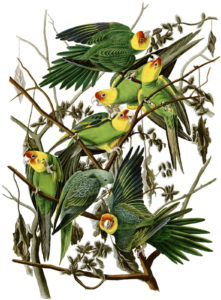 At one time, believe it or not, we had a common and colorful parrot, found across the central and Eastern United States, ranging from Southern New England, west to Colorado, and south to Texas along the Gulf Coast to the tip of Florida. The Carolina Parakeet (Conuropsis carolinensis) could be found in temperate and sub-tropical areas of the country, and was the Northernmost parrot in the Americas. They ate mostly large seeds and small fruits. Its thought that their habit of eating poisonous cocklebur seeds may have made the birds themselves poisonous, protecting them from predators. These parakeets were gregarious, living in groups of 200-300 birds. They nested in old hollow trees, using species such as Sycamore and Bald Cypress, in old growth forests, along the edges of wetlands.
At one time, believe it or not, we had a common and colorful parrot, found across the central and Eastern United States, ranging from Southern New England, west to Colorado, and south to Texas along the Gulf Coast to the tip of Florida. The Carolina Parakeet (Conuropsis carolinensis) could be found in temperate and sub-tropical areas of the country, and was the Northernmost parrot in the Americas. They ate mostly large seeds and small fruits. Its thought that their habit of eating poisonous cocklebur seeds may have made the birds themselves poisonous, protecting them from predators. These parakeets were gregarious, living in groups of 200-300 birds. They nested in old hollow trees, using species such as Sycamore and Bald Cypress, in old growth forests, along the edges of wetlands. 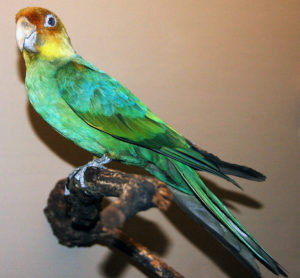
We could have seen this bird right here in Houston, if you had been here 150 years ago. Sometime in the mid 1800s though, the birds began to decline, and by 1918, the last known bird died at the Cincinnati Zoo… America’s gorgeous, gregarious, and relatively common parrots were extinct. The cause of extinction is thought to be a combination of factors that came along with European settlement and increasing population across the country. Logging of old growth forests and over-hunting for the millinery trade (feather’s for women’s hats) were the driving forces that lead to losing this beautiful bird.
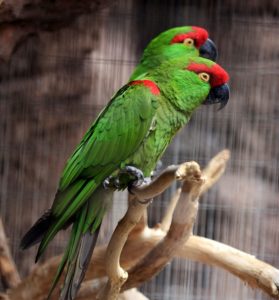
Another bird that we have lost in the United States is the endangered Thick-billed Parrot (Rhynchopsitta pachyrhyncha), which thankfully still persists in the Sierra Madres of North-western Mexico. This large green and red parrot was once found in mixed oak and conifer forests in Arizona and New Mexico, and wandered occasionally to Utah and west Texas. Deforestation, general habitat disturbance, and over-hunting lead to dramatic declines, and the last reports of the birds in the U.S. (in SE Arizona) were in the mid 1930s. In the 1980s, the government attempted to reintroduce them to SE Arizona, but dramatic changes in habitats and intense human settlement doomed the project to failure. Most of the introduced birds fell victim to predators or left for Mexico, and the project of bringing them back to the U.S. was abandoned.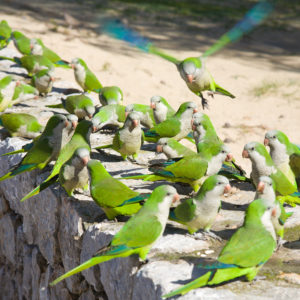
Today, parrots present in the United States are mostly introduced species, released and escaped pets. Here in Houston, as well as in NY, Chicago, Cincinnati, St. Louis, and other urban areas across the Eastern half of the country, Monk Parakeets (Myiopsitta monachus) aka “Quaker Parrots” have taken a foothold. This is our most common introduced parrot, and it fills some of the niches of the extinct Carolina Parakeet, feeding on seeds and grain, and nesting in large colonies. Their huge group nests can be seen in power line towers around the city, including right here in Bellaire. They can be seen feeding at bird feeders and on lawns nearby, as well as on Green Ash seeds here at the Nature Center.
 Besides Monk Parakeets, and the occasional escaped Budgie, released Red-masked parakeets live in San Francisco, and various species of Amazon parrots live in South Texas and Southern Florida. Red-crowned parrots and Green Parakeets nest in the most Southern parts of the Rio Grande Valley of Texas, though its not clear if they are released pets, or whether Mexican populations have begun to creep slowly into the U.S.
Besides Monk Parakeets, and the occasional escaped Budgie, released Red-masked parakeets live in San Francisco, and various species of Amazon parrots live in South Texas and Southern Florida. Red-crowned parrots and Green Parakeets nest in the most Southern parts of the Rio Grande Valley of Texas, though its not clear if they are released pets, or whether Mexican populations have begun to creep slowly into the U.S.
Though you can no longer see Carolinas or Thick-bills in the U.S., you can see Monk Parakeets here in the park, in the trees in front of Whole Foods in West University, and in the power line right of way between Newcastle and Weslayan on Bellaire, on warmer days. If you get a chance, get out and experience these delightful little parrots for yourself.
Thanks for joining us, and see you in the park!
Eric Duran
Staff Naturalist
If you’d like to know more about local birds, or birds int he park, feel free to email: eduran@naturediscoverycenter.org
images: Illustration by John James Audubon (1833); Carolina Parakeet – James St. John | Wiki; Thick-billed Parrot – Tim Lenz | Wiki; Monk Parakeets – Tamara K. | Wiki; Red-crowned Parrot – Roger Moore | Wiki


